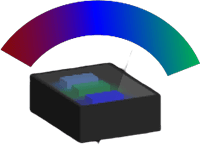


DVX Studio – XR LED Display Solution for Virtual Production
Unlock the full potential of your virtual production and Extended Reality (XR) projects with the Dynamo LED DVX Studio display. Engineered for unparalleled performance, DVX Studio is your definitive answer to creating seamless, immersive virtual environments that captivate audiences and empower creative vision.
Flawless Visual Fidelity, On-Camera Perfection
Achieve razor-sharp clarity, especially through the lens. Standard LED panels often render 1px lines and dots as a ‘grey blur’ when captured by cameras. DVX Studio panels are meticulously designed to eliminate this issue, ensuring every intricate detail of your virtual set – from subtle textures to fine lines – is displayed and recorded with pixel-perfect precision. This guarantees superior camera coverage and an uncompromised visual experience for your audience.
Impeccable Colour Reproduction and Gradient Smoothness
Experience true-to-life colours and flawless transitions that elevate your virtual worlds. Our advanced colour gradient testing ensures DVX Studio delivers consistent, natural grayscale and vibrant RGBW ranges, from deep blacks to brilliant whites. We meticulously address potential issues like inconsistent gamma or module grid problems, guaranteeing smooth, accurate gradients that meet rigorous Rec. 709 standards.
Eliminate Motion Blur and Unwanted Artefacts
Say goodbye to distracting motion blur and noise around talent. In high-stakes virtual production environments, actors moving in front of conventional LED screens can result in unnatural ghosting and visual interference. DVX Studio’s superior engineering ensures fluid, natural motion capture, keeping your subjects sharp and your virtual backgrounds pristine, even during the most dynamic scenes.
Seamless Camera Synchronisation with Genlock
Achieve perfect harmony between your cameras and LED display. DVX Studio fully supports Genlock synchronisation, utilising the camera’s frame generation pulse for precise alignment. This critical feature ensures smooth, tear-free footage, preventing frustrating visual discrepancies. Our panels are compatible with industry-leading control systems including Colorlight, Novastar, and Brompton, integrating effortlessly into your existing workflow.
Conquer Moiré and Colour Shift Challenges
Combat common visual obstacles that compromise production quality. Moiré patterns, caused by the interplay between LED pixel grids and camera sensors, are significantly minimised. Understanding critical factors – pixel pitch, brightness, camera lens, focus, and refresh rate – we engineer our displays to reduce these effects. Furthermore, we eliminate disruptive colour shifts (blue, red, or yellow), ensuring stable, accurate hues across your entire display. For optimal results, a camera-to-screen distance of approximately 2 metres is recommended to further mitigate moiré.
Expansive, Consistent Viewing Angles
Deliver a flawless visual experience from every perspective. DVX Studio provides exceptional viewing angles of 170˚-175˚ for wall displays, and a full V360˚ for floor panels, far surpassing the limitations of regular SMD displays. This wide, consistent viewing performance eliminates frustrating colour shifts from various angles, guaranteeing your virtual environment looks perfect from any perspective, for both talent and camera.
Dynamic Reliability and Flawless Grayscale Control
Trust a display engineered for dynamic, real-world production demands. DVX Studio ensures impeccable grayscale control, preventing common issues like visible smoke effects, black or white lines, and uniformity problems. Our panels eliminate scan lines and frame sync issues even when cameras are tilting up or down, providing rock-solid stability for every shot. This means consistent, beautiful imagery across all dark and white areas, critical for believable virtual sets.
Cinema-Grade Colour and HDR Performance
Experience cinematic colour. DVX Studio proudly achieves DCI-P3 >90% and BT.2020 >80% coverage, exceeding industry benchmarks for digital cinema and HDR content. With isotropic emission, our panels deliver uniform colour and brightness from all angles, ensuring consistent, true-to-life visuals, without the typical limitations of conventional displays. Prepare for breathtaking, vibrant colour reproduction that meets the most demanding creative specifications.
Ultra-Low Latency for Real-Time Interaction
Achieve instant responsiveness, crucial for live virtual productions. While conventional systems can suffer significant latency (up to 0.334 seconds at 60Hz due to chip and receiver delays), DVX Studio is engineered for minimal lag. Our advanced processing and module design dramatically reduce latency, ensuring real-time interaction between talent and virtual environments. This translates to a seamless, immersive experience, free from disruptive delays.
Built for Challenging Environments: Water & Dirt Resistant
Don’t let elements limit your creative vision. DVX Studio boasts robust water and dirt resistance, offering unparalleled protection for special scenes involving weather changes, rain, water splashes, or dirt. This durability ensures your display remains undamaged and fully functional, allowing you to create truly dynamic and immersive virtual environments without compromise.
Exceptional Colour Space Coverage & Luminance
Experience an expanded spectrum of colour and brightness. DVX Studio delivers an average achievable luminance of 3389 Nits at D65, providing stunning brightness for impactful visuals. With impressive Rec. 2020 green coverage at 80.1% and blue coverage at 87%, our panels render an incredibly wide, accurate colour gamut, bringing unprecedented depth and realism to your virtual sets.
Dynamic Brightness for Superior HDR Effects
Unleash HDR’s full potential with DVX Studio’s exceptional brightness. Exceeding the HDR+ standard of 3000 cd/m², our panels reach up to 3389 Nits, dramatically enhancing explosions, vehicle lighting, and other high-impact visual effects. Beyond stunning HDR, this superior brightness also contributes to lower power consumption, improved white uniformity, and an extended product lifetime, ensuring performance and efficiency.
Robust Floor Uniformity and Performance
Experience ground-breaking floor display technology. DVX Studio addresses common issues like uneven flatness, high reflection, and durability challenges. Our floor panels deliver exceptional uniformity and stability, boasting an 85D hardness for rigorous production demands. With integrated water protection and fine pitch solutions, you can create immersive floor-based virtual elements without compromising quality, colour, or structural integrity.
Industry-Leading Refresh Rate: 7860Hz
Set a new standard for flicker-free virtual production. While 1920Hz is a minimum for camera compatibility and 3840Hz is standard for many XR solutions, DVX Studio pushes boundaries with an astounding 7860Hz refresh rate. This exceptional performance virtually eliminates scan lines, flicker, and strobing when filmed, ensuring ultra-smooth, professional-grade footage.
Unmatched Frame Rate: Up to 240Hz
Unlock truly dynamic, responsive virtual worlds. DVX Studio supports an impressive frame rate from 60Hz up to 240Hz, far exceeding the standard 60Hz. This increased frame rate is critical for reducing latency, providing a dramatically more fluid, interactive experience for both talent and camera. At 240Hz, you achieve a 4x improvement in responsiveness across receiver and processor, ensuring your virtual content is always in perfect sync with live action.
Explore the Future of Virtual Production
Discover how DVX Studio’s unparalleled specifications and robust design can transform your next XR project. For detailed technical specifications or to discuss your bespoke virtual production needs, please contact our expert team.
Virtual Production
Curve Wall Display
Ceiling Display

DVX Studio - XR LED Display Solution for Virtual Production


Extended Reality
Floor Display
Curved Wall Display
Straight Wall Display



Pattern test





The thickness of the line pattern is as follows.
7px | 4px | 2px 1px
When viewed through the camera, most products display the fourth square (1px) as a grey blur rather than a line

The 1px Dot pattern allows to test for
correct camera coverage.
Many products will display grey blur
rather than dot pattern.





Colour Gradient Test
Gradient test is important and is like grayscale test
From black to RGBW and from RGBW to White
RGBW : Red Green Blue White



Fast Motion Test
This is caused when an actor moves in front of the screen on the actual Virtual Production environment. Many products have unnatural motion blur or noise around people.
Noise Around Person
Screen Blur









Genlock Sync
Genlock synchronises the cameras. It uses the pulse that generates the frames within the camera as the synchronisation point. Controlling System: Colorlight, Novastar and Brompton support Genlock

Moiré
Moiré happens because your LED panels are made up of a tight grid of individual LED pixels. The sensor that captures the image in a digital camera also works on a grid system, using an array of millions of tiny light cavities, or “photosites”. They will never be in perfect alignment with each other and the clash of the two causes moiré.
(Don’t let the Camera focus on the screen)
- Effected Causes
- Pitch Difference
- Brightness
- Camera Lens
- (Best Object 2 meter from screen)
- Camera Focus
- Refresh rate




Blue Colour Shift
Red Colour Shift
Red / Blue / Yellow Colour Shift

Viewing Angle Test
Regular SMD
Wall Angle 110˚ - Left Right Colour Shift
Floor 110˚ - Left Right Front Back Color Shift


Wall Angle 170˚ - 175˚
Floor V360˚


Visible Smoke Test
Module Gray Scale Control Issue
Resolved




Tilt Up and Down Test
Camera being moved up and down can result in visible scan lines / frame sync issues.

- Camera
- Moving Up
- Moving Down
Dark & White Area Test
Important reality test Common Issues: Black lines, White Lines, Uniformity, Grayscale…





DCI-P3 Standard
Digital Cinema Initiatives

DCI-P3 >90%
BT.2020 >80% HDR

DCI-P3 >90%
BT.2020 >80% HDR

Isotropic Emission
Isotropic Emission

Package Limit:
- Colour
- Brightness
- Viewing Angle

Latency
- Driving Chip lose 1 frame on 60Hz = 0.167seconds
- Receiver lose 1 frame on 60Hz = 0.167seconds
- Total of 2 frames on 60Hz = 0.334 seconds
- By adding processing and correct module design can improve the low latency
60Hz = 0.167s –
0.334s
Change of 60Hz to 120Hz will reduce the latency time
by half







60Hz = 0.167s – 0.334s


Water resistant

Dirt resistant

Protection
Special scenes weather scenes that involves
Weather changes, Rain, Water Splash, Dirt …
It important that the display will not be harmed by these actions
Colour Space Test
3389 Nits
Average Achievable Luminance at D65
84.1 %
Average Achievable Luminance at D65
80.1 %
Average Rec. 2020 Green Coverage
87 %
Average Rec. 2020 Blue Coverage


Brightness Test
Higher Brightness will improve HDR Effect
HDR+ Standard requires the display to achieve 3000 cd/m2
Brightness will increase explosion, car lighting effect and much more
Other Benefit: lower consumption, better white uniformity range, Longer Lifetime

Floor uniformity Test
Common Issues:
Floor Flatness, High Reflection, Weak, No Fine Pitch
Solutions, Colour Shift, No Water Protection…


Floor Hardness 85D

Refresh Rate
- 1920Hz is the minimum for most of the camera.
- 3840Hz is standard for most XR solutions available.
- DVX Studio is 7860Hz



>= 3840Hz


FPS - Frame Rate
- Standard 60Hz
- Market requirement 60Hz – 240Hz
- Increased frame rate can improve the latency.
- From 60Hz to 120Hz = 2X , Receiver = 2X, Processor = 2X
- From 60Hz to 240Hz = 4X , Receiver = 4X, Processor = 4X



60Hz – 240Hz








